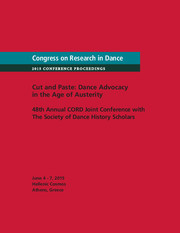No CrossRef data available.
Article contents
Aspects of Professional Dance Education in Greece
Published online by Cambridge University Press: 02 August 2016
Abstract
My PhD research focuses on public professional dance education in Greece. The two Greek schools that are free of tuition constitute the research field: the State School of Dance and the Professional Dance School of the Greek National Opera. The theoretical framework draws from the works of Pierre Bourdieu on the concepts of field, habitus, and capital, as well as from Bryan Turner, Steven Wainwright, and Clare Williams's adaption of them for the field of dance and also, the works of Michel Foucault on the concepts of discipline and the technologies of the self. The material has been collected through a combination of student/faculty interviews and field observation. The basic points of the research are the student selection process and possible inequalities that might take root throughout the three-year education, the aesthetic canon of each academy and the impact on teaching and identity formation, the disciplinary methods and the technologies that the students form, the role of gender, the shape of the dancer's body, and the relation between the educational and the market field. These aspects are considered through a critical perspective, in close relation to the historical configuration of the Greek and the international dance field.
- Type
- Research Article
- Information
- Copyright
- Copyright © Daphne Mourelou 2016


